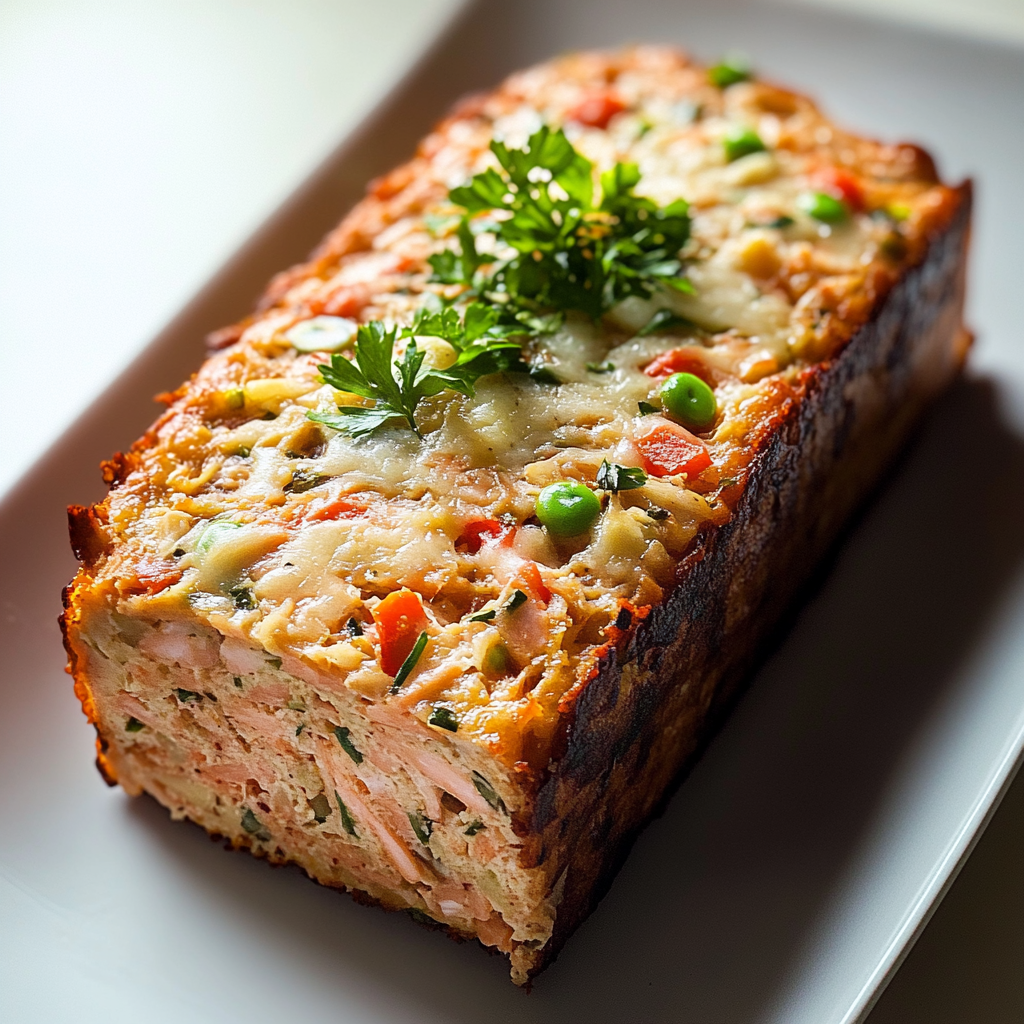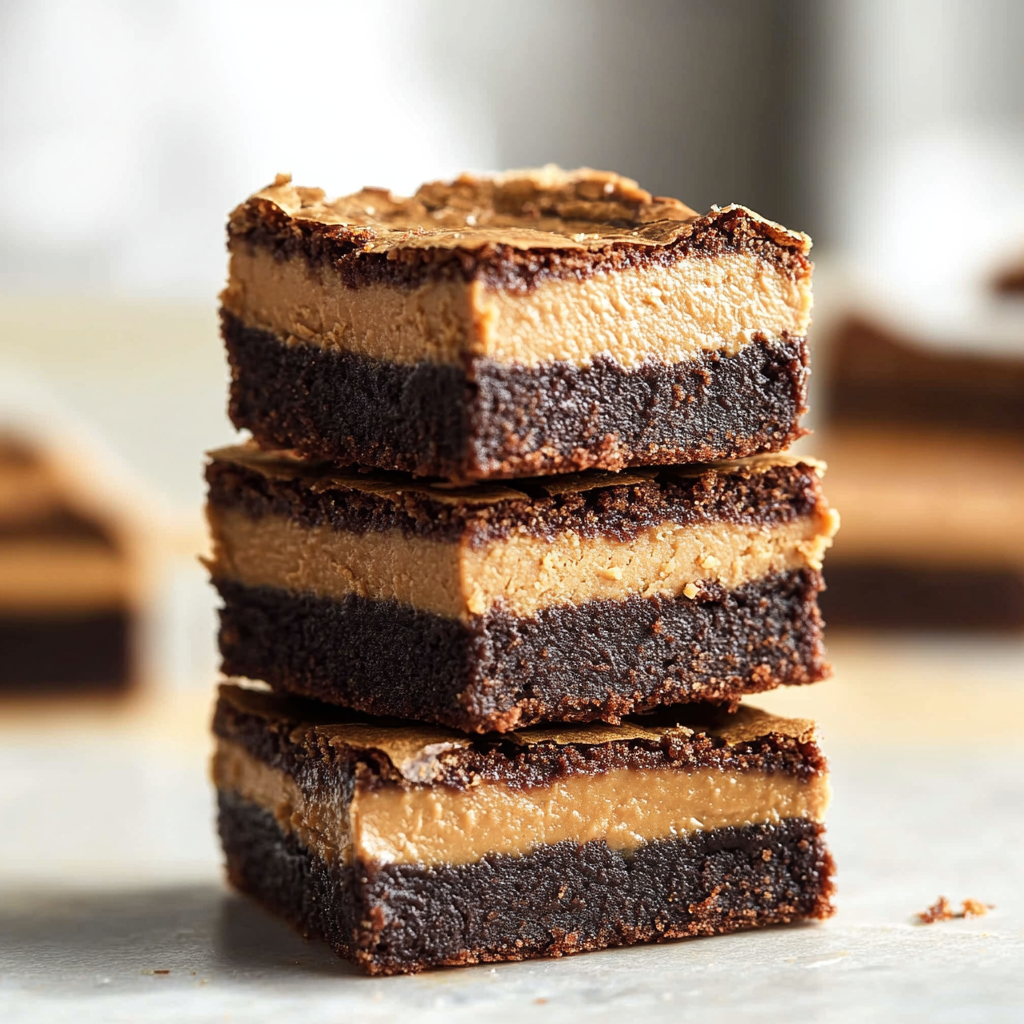Introduction
Have you ever craved a dish that combines the rich flavors of salmon with a comforting texture? The aroma of a perfectly baked Salmon Loaf wafting through your kitchen can awaken memories of family gatherings and cozy dinners. This delightful dish is not only pleasing to the senses but also serves as a nutritious option for meal prep or special occasions.
Imagine slicing into a golden brown loaf that boasts tender flakes of salmon mixed with aromatic herbs and spices. Each bite delivers a burst of flavor, making it an unforgettable centerpiece for dinner parties or a simple weeknight meal. Whether served with a fresh salad or creamy mashed potatoes, this Salmon Loaf promises to be a crowd-pleaser that brings smiles all around.
Why You’ll Love This Salmon Loaf
Healthy and Nutritious: Salmon is rich in omega-3 fatty acids, protein, and essential vitamins. By incorporating it into this loaf, you’re providing your body with beneficial nutrients that promote heart health and overall well-being.
Versatile Meal Option: This Salmon Loaf can be enjoyed in various ways. Serve it warm with sides like veggies or salad for dinner or cold as a sandwich filling for lunch. Its adaptability makes it perfect for any mealtime.
Simple Preparation: You don’t need culinary expertise to create this dish. With straightforward ingredients and uncomplicated steps, even beginner cooks can impress their family and friends without stress.
Freezer-Friendly: Prepare in advance by freezing individual slices or the entire loaf. This allows you to enjoy homemade meals on busy days without compromising on quality and taste.
Ingredients
Here’s what you’ll need to make this delicious dish:
- Canned Salmon: Choose high-quality canned salmon packed in water or oil for optimal flavor. Draining it properly ensures the right consistency.
- Breadcrumbs: Use plain or seasoned breadcrumbs as they provide structure to the loaf while absorbing moisture.
- Eggs: Two large eggs help bind the ingredients together, giving the loaf its shape and firmness.
- Onion: Finely chopped onion adds sweetness and depth of flavor; choose yellow or sweet onions for the best result.
- Dill: Fresh dill complements salmon beautifully. If fresh isn’t available, dried dill works as an alternative.
For added flavor:
- Lemon Juice: Fresh lemon juice brightens the dish and balances the richness of the salmon.
The full ingredients list, including measurements, is provided in the recipe card directly below.
How to Make Salmon Loaf
Follow these simple steps to prepare this delicious dish:
Preheat Your Oven: Preheat your oven to 350°F (175°C). Grease a loaf pan with cooking spray or line it with parchment paper for easy removal later.
Prepare the Mixture: In a large mixing bowl, combine drained canned salmon, breadcrumbs, finely chopped onion, eggs, dill, salt, pepper, and lemon juice. Mix until well combined but avoid over-mixing.
Add to Pan: Transfer the mixture into your prepared loaf pan. Press down gently to ensure an even surface throughout the loaf.
Bake It Up: Place the filled pan in the preheated oven and bake for about 45-50 minutes or until golden brown on top and firm in texture.
Cool Before Slicing: Once done baking, remove from oven and allow it to cool in the pan for about ten minutes before turning out onto a wire rack. This helps maintain its shape when slicing.
Transfer to plates and drizzle with sauce for the perfect finishing touch.
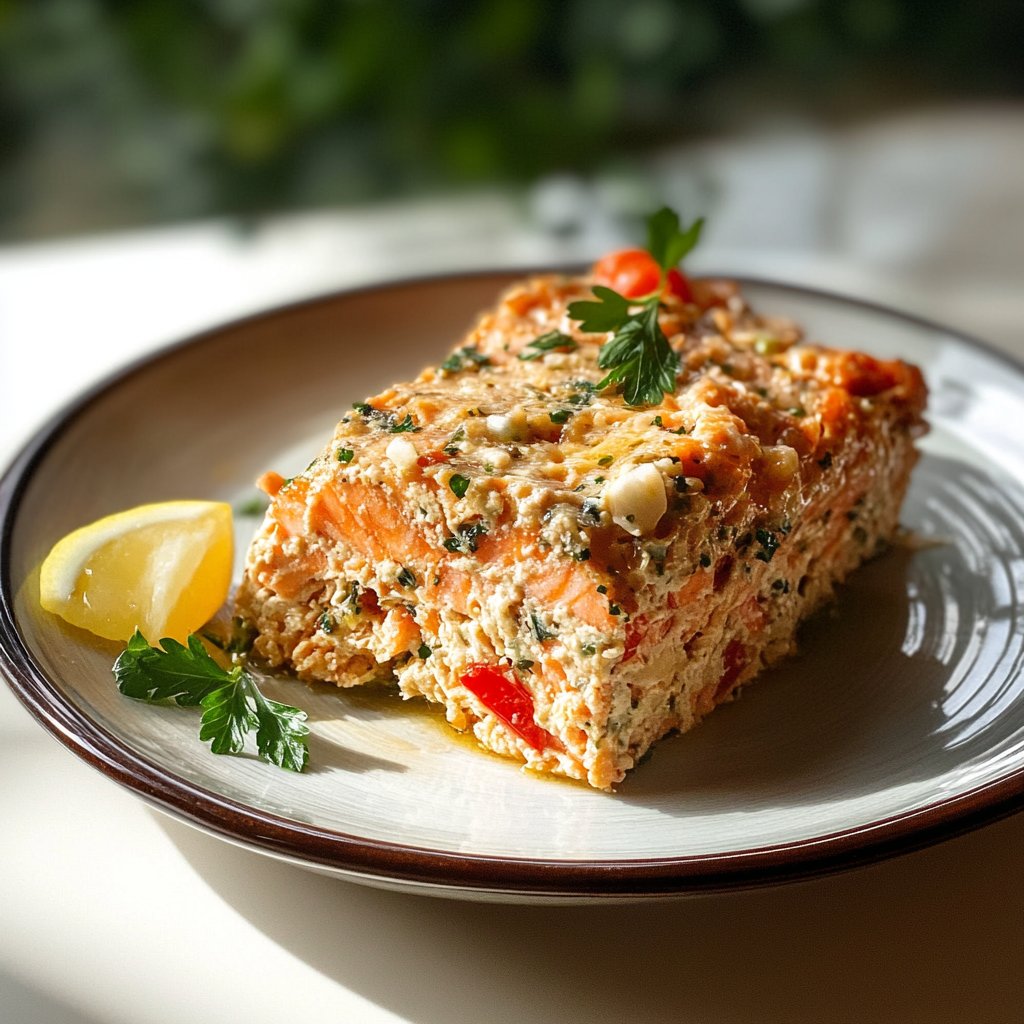
Tips and Tricks
Here are some helpful tips to ensure the best results for your dish:
Use Fresh Ingredients: Opt for fresh herbs like dill whenever possible; they greatly enhance flavor compared to dried alternatives.
Adjust Seasonings: Feel free to customize seasoning levels according to your taste preferences; adding more spices can elevate your Salmon Loaf significantly.
Avoid Overmixing: When combining ingredients, mix just enough so everything blends well; overmixing can lead to a dense texture rather than a light one.
Check Doneness Carefully: Use a toothpick inserted into the center of the loaf; if it comes out clean or with just crumbs attached, it’s ready!
Experiment with Add-ins: Consider adding chopped bell peppers or grated carrots for extra nutrition and color; these additions can enhance both texture and flavor.
Mistakes to avoid
Using the wrong type of salmon Choosing the right salmon is crucial for a delicious salmon loaf. Many recipes call for canned salmon, but using fresh or frozen fillets can enhance the flavor and texture. Avoid using farmed salmon, as it tends to have a higher fat content and less flavor. Opt for wild-caught varieties like Sockeye or Coho for the best taste. If you do use canned salmon, ensure it’s packed in water and drained thoroughly to prevent excess moisture that could lead to a soggy loaf.
Neglecting to season properly Seasoning is key in making your salmon loaf flavorful. Many people skip this step thinking the fish itself has enough flavor. However, adding salt, pepper, and herbs enhances the overall taste significantly. Don’t forget about aromatics such as garlic and onion; they add depth to your dish. Always taste your mixture before baking it; if it lacks flavor when raw, it will be bland after cooking. A well-seasoned loaf will shine at the dinner table.
Overmixing the ingredients When preparing your salmon loaf, it’s important not to overmix the ingredients. Overmixing can lead to a dense texture rather than a light and fluffy one. Combine the ingredients just until they are evenly distributed. This helps maintain a pleasant mouthfeel in every bite. Gently fold in breadcrumbs or other binders to keep your salmon loaf tender. Remember that less is often more when it comes to mixing; treat your mixture delicately.
Baking at incorrect temperatures The temperature at which you bake your salmon loaf can make or break its success. Baking it too hot can cause the outside to brown while leaving the inside undercooked. The ideal baking temperature is around 350°F (175°C). This allows for even cooking throughout without excessive drying out of the exterior. Always check for doneness with a food thermometer; the internal temperature should reach 145°F (63°C) for safe consumption.
Skipping cooling time After baking your salmon loaf, resist the urge to cut into it immediately. Allowing it to cool for at least 10 minutes before slicing helps set its structure, making serving easier and neater. Cutting too soon can result in a crumbly mess rather than perfectly shaped slices. This cooling period also allows flavors to meld together better, enhancing the overall taste experience when you finally serve it up on your plate.
Serving Suggestions
This Salmon Loaf is versatile and pairs wonderfully with a fresh garden salad. A simple mix of mixed greens, cherry tomatoes, and a light vinaigrette enhances the meal’s freshness. The crispness of the vegetables contrasts beautifully with the moist texture of the salmon loaf, creating a balanced dish that is both satisfying and healthy. Serve this combination for lunch or dinner to impress your family or guests.
Mashed Potatoes
Creamy mashed potatoes complement the flavors of the Salmon Loaf perfectly. Prepare them with butter, cream, and a hint of garlic for added flavor. The richness of the mashed potatoes contrasts nicely with the lightness of the salmon, making every bite delightful. Serve this pairing alongside steamed asparagus or green beans for an elegant touch.
Quinoa Salad
For a healthy twist, consider serving your Salmon Loaf with a quinoa salad. Toss cooked quinoa with diced cucumbers, bell peppers, and a squeeze of lemon juice for zest. This nutritious side adds texture and flavor while being light on calories. It’s an excellent option for those looking to maintain a balanced diet without sacrificing taste.
Roasted Vegetables
Roasted vegetables make an excellent side dish for Salmon Loaf. Choose seasonal vegetables like carrots, zucchini, and bell peppers. Drizzle them with olive oil and sprinkle some herbs before roasting at 425°F (220°C) for about 25 minutes. The caramelized edges add depth to your meal while keeping it colorful and appealing.
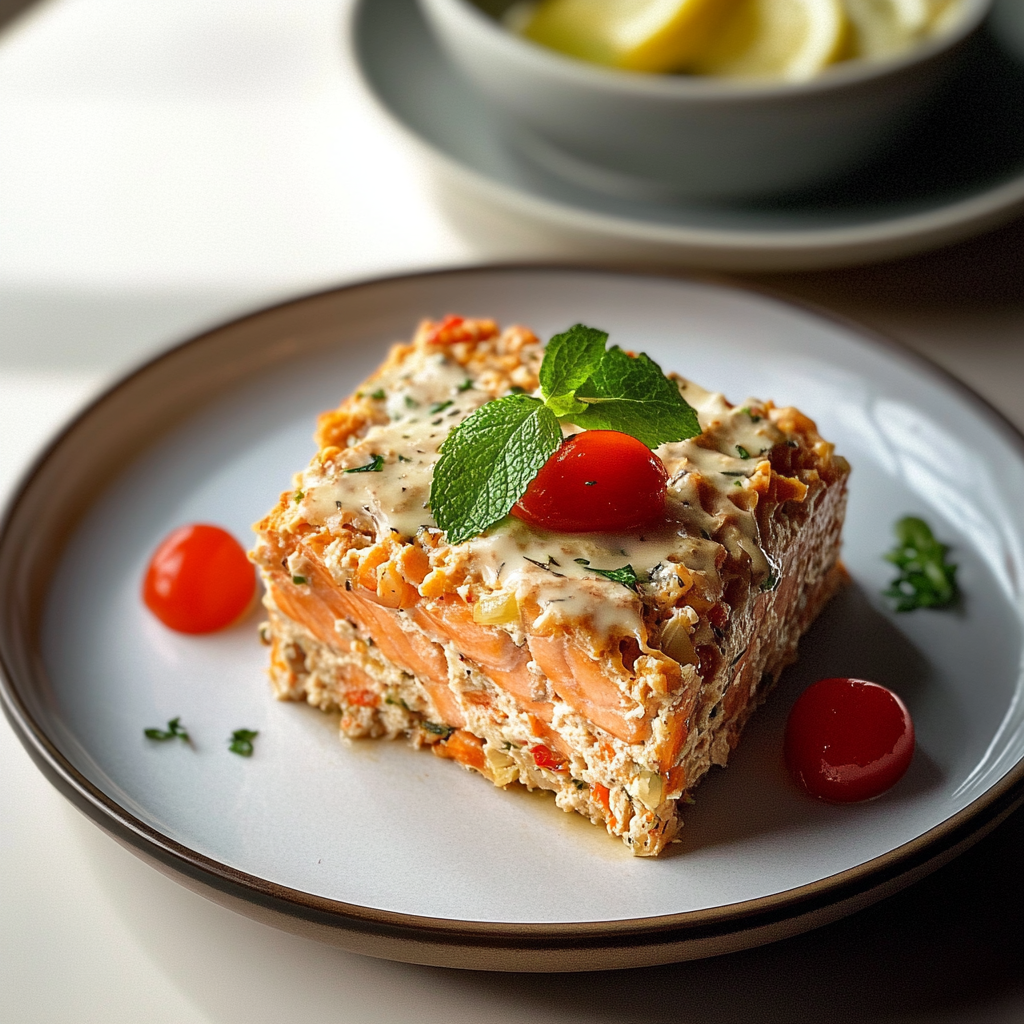
FAQs
What is the best way to store leftover Salmon Loaf?
To store leftover Salmon Loaf, wrap it tightly in plastic wrap or aluminum foil and place it in an airtight container. Keep it in the refrigerator for up to three days. If you want to keep it longer, consider freezing it for up to three months. When ready to eat, thaw overnight in the fridge and reheat in the oven at 350°F (175°C) until warmed through.
Can I use canned salmon for this recipe?
Yes, you can use canned salmon for making Salmon Loaf. It provides great convenience while ensuring delicious results. Drain the canned salmon well before mixing it with other ingredients to avoid excess moisture, which can affect the loaf’s texture during baking.
How can I customize my Salmon Loaf?
You can customize your Salmon Loaf by adding various ingredients such as chopped herbs like dill or parsley, or even incorporating vegetables like spinach or bell peppers into the mix. Experimenting with spices such as Old Bay seasoning or lemon zest can also enhance its flavor profile according to your preferences.
Is Salmon Loaf healthy?
Yes, Salmon Loaf is generally a healthy meal option as salmon is rich in omega-3 fatty acids, protein, and essential nutrients. By using whole grain breadcrumbs and incorporating vegetables into your loaf mixture, you can increase its nutritional value while keeping it low in saturated fats.
Conclusion
In summary, Salmon Loaf is a delightful dish that offers both flavor and nutrition. It pairs excellently with various sides like fresh salads, creamy mashed potatoes, quinoa salads, or roasted vegetables that enhance its taste profile while providing balance to your meal. You can easily store leftovers for later enjoyment or customize it with different ingredients based on personal preferences. Whether you’re preparing this dish for family dinners or special occasions, it’s sure to please everyone at your table while being a wholesome option worth trying again and again!
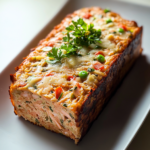
Salmon Loaf
- Total Time: 1 hour 5 minutes
- Yield: Serves approximately 6 slices 1x
Description
Salmon Loaf is a delightful dish that combines the rich, savory flavors of salmon with wholesome ingredients, making it a nutritious option for any meal. This easy-to-follow recipe allows you to create a tender, flaky loaf that’s perfect for weeknight dinners or special occasions. Each slice bursts with flavor from fresh herbs and spices, while its moist texture pairs beautifully with fresh salads or creamy sides. Whether you opt for convenient canned salmon or fresh fillets, this Salmon Loaf is sure to impress your family and friends. With heart-healthy omega-3 fatty acids and essential nutrients packed into every bite, it’s a delicious way to enjoy seafood at home.
Ingredients
- 1 can (14.75 oz) high-quality canned salmon, drained
- 1 cup plain breadcrumbs
- 2 large eggs
- 1 medium onion, finely chopped
- 2 tablespoons fresh dill (or 1 tablespoon dried dill)
- 2 tablespoons lemon juice
- Salt and pepper to taste
Instructions
- Preheat your oven to 350°F (175°C). Grease a loaf pan or line with parchment paper.
- In a large bowl, combine drained salmon, breadcrumbs, chopped onion, eggs, dill, lemon juice, salt, and pepper. Mix until combined but do not overmix.
- Transfer the mixture into the prepared loaf pan and press down gently to ensure an even shape.
- Bake for 45-50 minutes until golden brown on top and firm in texture.
- Allow to cool in the pan for 10 minutes before transferring to a wire rack for slicing.
- Prep Time: 15 minutes
- Cook Time: 50 minutes
- Category: Main
- Method: Baking
- Cuisine: Seafood
Nutrition
- Serving Size: 1 slice (100g)
- Calories: 210
- Sugar: 1g
- Sodium: 480mg
- Fat: 9g
- Saturated Fat: 2g
- Unsaturated Fat: 6g
- Trans Fat: 0g
- Carbohydrates: 22g
- Fiber: 1g
- Protein: 14g
- Cholesterol: 80mg
